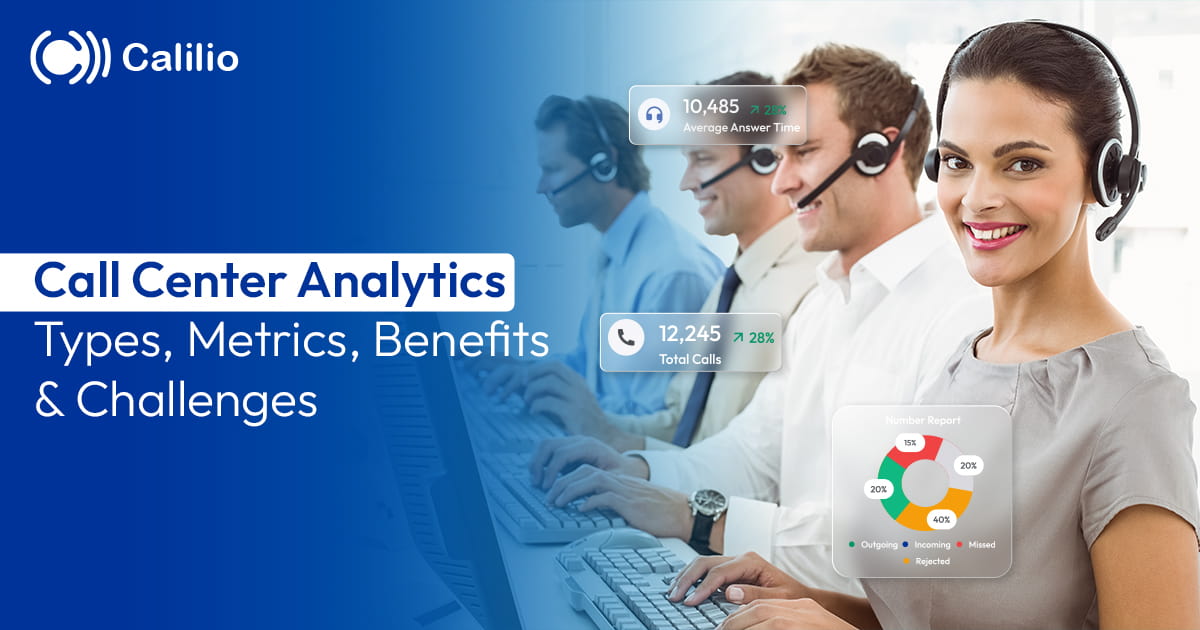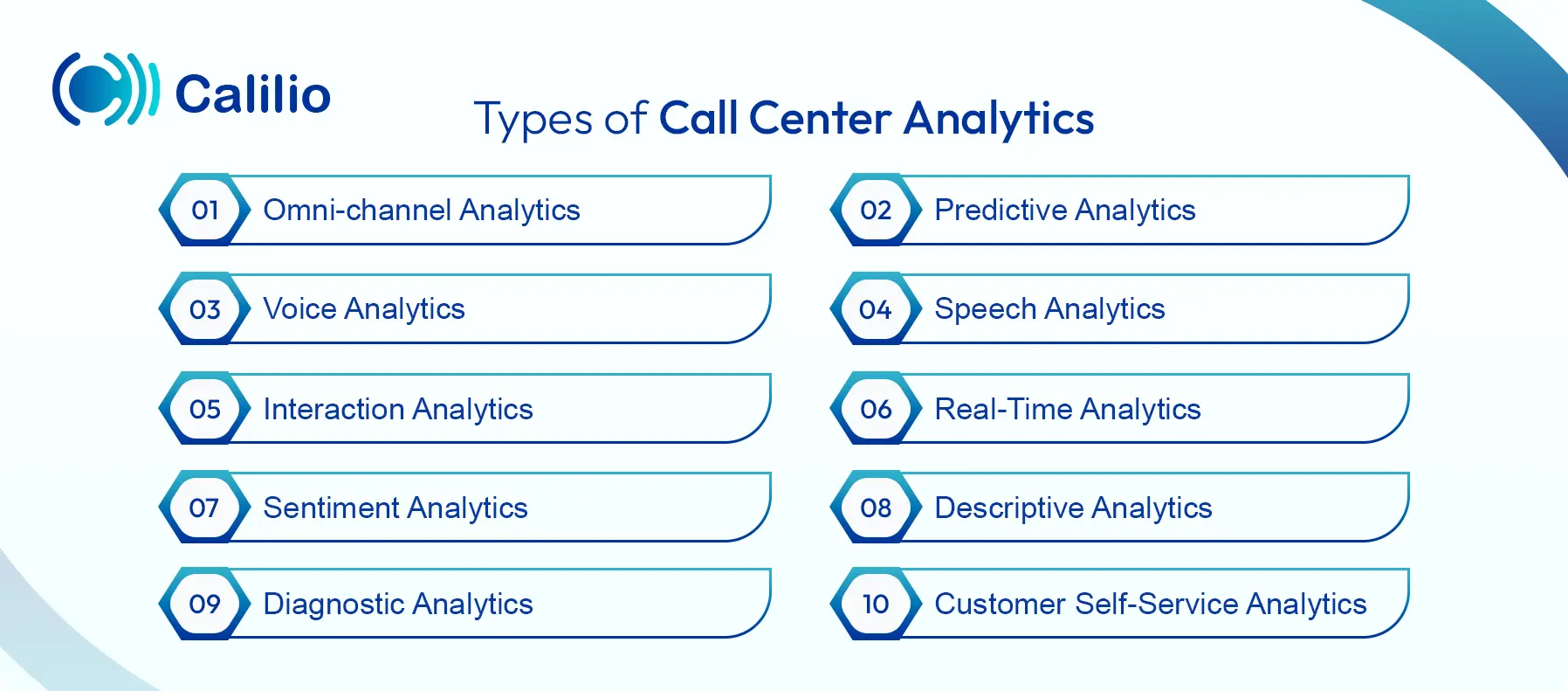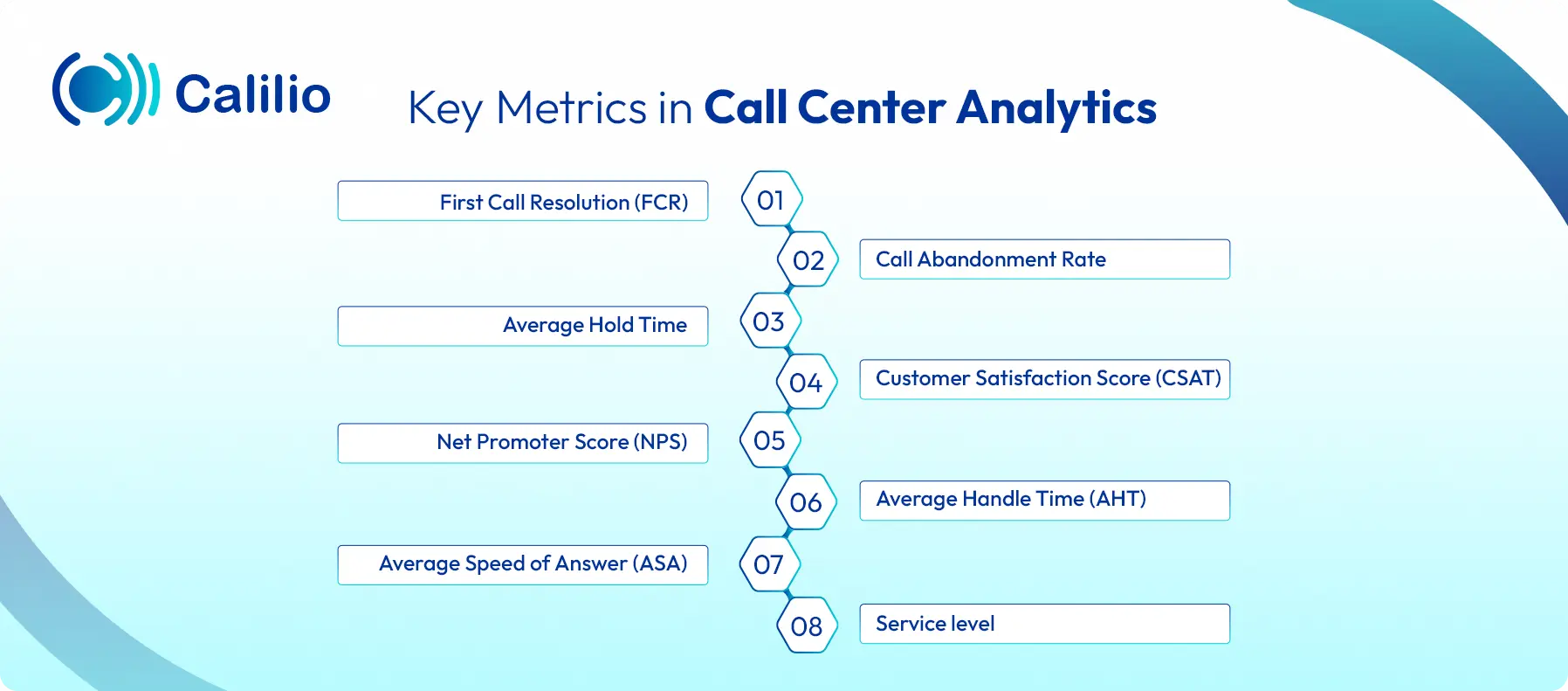Call Center Analytics: Everything You Need to Know

Running a call center comes with constant challenges such as long wait times, high call volumes, and customers expecting quick, reliable service. Even with strong phone systems and call management tools, the absence of proper analysis leaves managers struggling to understand performance.
This is where call center analytics comes in. By studying data from calls, chats, and other interactions, it reveals what customers need, how agents are performing, and where processes can improve.
In this blog, we’ll cover what call center analytics is, its different types, why it matters, how it works, the key metrics to track, common challenges, and the best practices for getting started.
Key Highlights:
Call center analytics is the process of studying customer interaction data to improve service, efficiency, and decision-making.
Some types of contact center analytics are speech, voice, predictive, real-time, sentiment, interaction, and omnichannel analytics.
Call center analytics helps call centers deliver better customer experiences, stronger agent performance, and improved operational efficiency.
Common challenges include data silos, poor data quality, lack of integration, and limited staff training.
Best practices are to set clear goals, choose the right tools, review data often, and involve both managers and agents.
What is Call Center Analytics?
Call center analytics is the process of collecting and analyzing data from customer interactions to improve performance. It shows what’s working well and where improvements are needed by measuring call activity and outcomes.
The data for call center analysis comes from sources such as call recordings, transcriptions, customer surveys, and system logs. Contact center analytics tools use this information to track key metrics, so managers can easily spot areas for improvement and take action to improve call center performance overall.
Types of Call Center Analytics
Depending upon the data and goals, there are many types of call center analytics. Some of them are:

1. Omni-channel Analytics
It looks at data across phone, chat, email, SMS, and social media to give a full picture of the customer journey. It helps spot patterns across all channels, not just calls.
2. Predictive Analytics
Predictive analytics uses historical data to forecast future events like call volume, customer needs, or potential churn. It is essential in workforce management and scheduling to improve proactive support.
3. Voice Analytics
Call center voice analytics examines vocal elements in conversations, such as tone, pitch, pace, and stress. It uses these cues to detect customer emotions, engagement levels, and potential dissatisfaction.
4. Speech Analytics
Call center speech analytics converts spoken conversations into text and analyzes the transcripts to identify keywords, themes, compliance risks, and customer concerns. These transcripts can then be used for deeper analysis and play a key role in quality assurance, helping check whether agents have followed QA guidelines.
5. Interaction Analytics
Interaction analytics is the examination of customer conversations across all communication channels to identify patterns, recurring issues, and opportunities for service improvement.
6. Real-Time Analytics
Real-time analytics captures and processes customer interaction data the moment it happens. It delivers instant feedback and alerts that help supervisors and agents steer live conversations.
7. Sentiment Analytics
Sentiment analytics identifies customer emotions during interactions. Sentiment analysis relies on speech patterns, word choice, and tone to label the experience as positive, negative, or neutral.
8. Descriptive Analytics
Descriptive analytics looks at historical call center data to explain what has already happened. It summarizes key metrics, including call volumes, average handle time, and first call resolution rates. This helps teams understand past performance and spot areas that may need improvement.
9. Diagnostic Analytics
Diagnostic analytics determines the causes of performance outcomes. It identifies root issues of call center challenges, such as high abandonment rates or low resolution rates.
10. Customer Self-Service Analytics
Customer self-service analytics tracks and analyzes how customers use automated support tools such as IVR, chatbots, and knowledge bases. It measures their effectiveness and highlights areas that need improvement.
Why Does Call Center Analytics Matter?
Call center analytics is an important part of a call center as it finds what customers need and where they struggle. These call center insights help managers coach agents better and improve self-service tools. Due to this, detailed call center monitoring and evaluation help to find issues and make the call center better.
1. Actionable Customer Insights
Call analytics identifies customer pain points and service issues by analyzing real interactions and feedback. Instead of relying on guesswork, managers and agents can make informed decisions and address problems in order of urgency.
2. Improved Supervision and Agent Performance
Supervisors can monitor and track agent performance in detail, from call handling skills to compliance with scripts, and use that information to provide targeted coaching. This not only improves agent performance but also boosts overall productivity.
3. Better Self-Service
Businesses can find what works and what’s causing their problems through the IVR menus, chatbots, or help centers. These self-service tools allow businesses to collect insights directly from customers for better call center analysis.
4. Improved Customer Experience
With clearer data, businesses can shorten average wait times, resolve issues faster, and respond more personally, creating a smoother, more positive experience.
5. Increased Operational Efficiency
Call center analytics highlights areas where time or resources are wasted, such as long handling times, repeated contacts, or inefficient call routing. Fixing these issues reduces costs and improves service at the same time. Plus, when agents understand what the customer needs with the help of call analysis, agents can provide service faster and resolve more issues, improving their productivity.
Turn Your Call Data Into Actionable Insights. Upgrade to Calilio’s Business Phone System with Ai-Powered Call Center Analytics.
How Does Call Center Analytics Work?
Call center analytics works by collecting data from every customer interaction, processing it, and turning it into reports or insights that managers and agents can act on.
- Data Collection
Information is gathered from different sources such as call recordings, real-time transcriptions, chat and email logs, CRM systems, surveys, and workforce management tools. - Data Processing
The raw information is cleaned, organized, and structured so it can be analyzed. For voice calls, this might mean converting speech into text, and for chat, it could mean tagging messages with categories. - Data Analysis
Analytics tools turn data on keywords, trends, sentiment, and performance into insights that show what’s happening, why it matters, and what’s next. With AI, they can filter through huge amounts of data to spot patterns, trends, and key metrics that help guide decisions. - Reporting and Dashboards
The results are then presented in dashboards and reports that supervisors and managers can easily understand. These call center metrics, analytics and reporting often include visual charts, KPIs, and alerts. - Actionable Insights
The insights are used to make improvements, such as coaching agents, changing call routing, or updating self-service tools. The cycle then repeats as new data is collected, ensuring continuous improvement.
Key Metrics in Call Center Analytics
Call center data analytics measures key metrics such as first call resolution, call abandonment, hold time, customer satisfaction score, total handle time, and average speed of answer. It also tracks average wait time, queue time, and service level, which is useful for evaluating performance.

1. First Call Resolution (FCR)
FCR is the measurement of the total number of customer issues resolved on the first contact without the need for follow-ups. A high FCR rate usually means customers are getting fast, effective help.
2. Call Abandonment Rate
Call abandonment rate is a measure of the total calls where callers hang up before reaching an agent. Analytics tools analyze calls and point out the causes of them, which are commonly due to long wait times or poor call routing.
3. Average Hold Time
Average hold time indicates how long customers spend on hold before speaking to an agent. It’s a key indicator of how well a call center manages traffic and resources.
4. Customer Satisfaction Score (CSAT)
CSAT score measures how satisfied customers are with the support they received, usually collected through surveys after a call. It reflects the quality of the interaction from the customer’s perspective.
5. Net Promoter Score (NPS)
NPS is a metric based on customer responses to how likely they are to recommend the company to others. It reflects overall loyalty and experience, going beyond the outcome of a single call.
6. Average Handle Time (AHT)
AHT combines the time an agent spends talking to the customer, the time they spend on hold, and any after-call work. It shows how much time, on average, agents spend handling a customer issue, including talk time, hold time, and after-call work.
7. Average Speed of Answer (ASA)
ASA tracks how long it takes, on average, for an agent to pick up a call after it enters the queue. It directly impacts customer wait time and overall satisfaction.
8. Service level
It is the percentage of calls answered within a set timeframe, such as 80% of calls answered within 20 seconds. It is one of the common benchmarks for call center efficiency.
Common Challenges in Call Center Analytics
Call centers face challenges like data silos, poor data quality, and tools that don’t integrate with key systems. Moreover, without proper training, staff may struggle to interpret analytics effectively and slow down the decision-making.
- Data Overload and Silos: Without the right system, large volumes of call center data often remain stuck in separate departments. The call center analytics tools should have a data source coming from all around the call center in a systematic way, without crowding and overloading the analyzer.
- Data Quality and Accuracy: Contact center analytics is good only when the data behind it is also reliable. Incomplete records, duplicate entries, or transcription errors can lead to misleading results and poor decisions.
- Lack of Proper Tools or Integration: When analytics tools don’t connect with CRM systems, call recording software, or workforce management platforms, managers have to piece together data manually, a slow and error-prone process.
- Training Staff to Use Analytics Effectively: Even the best software won’t help if staff don’t know how to interpret the results. Agents and supervisors need training to read dashboards, understand metrics, and act on the findings.
Best Practices for Getting Started With Call Center Analytics
If you’re getting started with analytics for your call center, you should begin by setting clear goals and KPIs, then choose software that fits your needs. You can make reviewing data a regular habit and train both managers and agents to use the tools effectively. Finally, you should share insights across the team so everyone contributes to improving performance and customer service.
1. Define Clear Goals and KPIs
First, you should set well-defined goals before using analytics. It's important to know what you want to achieve. This could mean reducing wait times, improving first call resolution, or raising customer satisfaction scores. Setting specific KPIs makes it easier to measure whether your efforts are working.
2. Choose the Right Software and Tools
Select the best call center analytics software that matches the size and goals of your call center. The right platform should offer essential features like CRM integration, speech analytics, and call recording, while providing real-time insights for quick decisions and historical reports for future planning.
3. Review Data Regularly and Take Action
Checking reports once in a while is not enough. You can build a routine to look at performance data often, compare it against your KPIs, and take action based on what you find. For example, if calls are being abandoned too often in peak hours, then you might need to assign more agents during peak hours.
4. Train Staff to Use Analytics Tools
Even the best platform won’t help if staff don’t know how to use it. As agents and managers are the primary users, the call center must train them to use, read dashboards, interpret metrics, and apply the findings in their day-to-day work.
5. Share Data Access Across the Team
The data and detailed insights from the analytics should not be limited to managers or supervisors. Sharing insights with agents helps them understand how they are performing and where they can improve. It creates a culture where everyone takes part in improving service quality and the call center.
Conclusion
Call center analytics transforms everyday customer interaction into clear information that managers and agents can actually use to improve service. It helps measure key metrics, highlight trends, and guide decisions that make call centers more efficient and customer-focused. By setting clear goals, using the right tools, and making data part of daily routines, call centers can improve agent performance, optimize the call center and give customers a smoother experience.
To implement these best practices into action, you can use Calilio, a call center solution. Calilio provides advanced call analytics to help call centers spot issues, improve performance, and make faster decisions. Its real-time monitoring dashboard tracks key metrics such as total handling time, idle time, and agent availability, giving managers a clear view of operations as they happen.

Get Cashbacks Up to 43% Straight To Your Wallet!
Unlimited Virtual Numbers – Local, Mobile & Toll-Free from 100+ Countries
Free Local Phone Number from US or Canada
Crystal-Clear Calls Starting at Just $0.0153/min
24/7 Human Support – Because Great Service Never Takes a Holiday


Frequently Asked Questions
What are the four types of analytics in a call center?
The four types of analytics are descriptive, diagnostic, predictive, and prescriptive analytics. They explain what happened, why it happened, what might happen next, and what actions to take in general.
What are the four common KPIs used in call centers?
What is a KPI scorecard for a call center?

Still have questions?
Can’t find the answer you’re looking for? Please chat with our friendly team.
Stay in the loop
Get the latest call insights, trends, and updates delivered straight to your inbox.
By subscribing, you agree to receive updates from Calilio.
You can unsubscribe anytime.